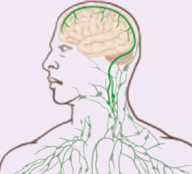Monday, 11 July 2016
A Vessel Connecting the Immune System to the Brain
 In brain science, as in any other branch of science, you should always be skeptical when you read that a “missing link” has been found and that this discovery will force the textbooks to be rewritten. Such skepticism is all the more appropriate when the discovery is described as something that was there all along and that scientists had simply failed to see. After all, for all intents and purposes, the human body has been regarded as almost completely mapped for some 50 years now.
In brain science, as in any other branch of science, you should always be skeptical when you read that a “missing link” has been found and that this discovery will force the textbooks to be rewritten. Such skepticism is all the more appropriate when the discovery is described as something that was there all along and that scientists had simply failed to see. After all, for all intents and purposes, the human body has been regarded as almost completely mapped for some 50 years now.
But in the case of a recent discovery by Antoine Louveau, a post-doctoral fellow at the University of Virginia School of Medicine, the extravagant claims seem to be true: he has discovered a lymphatic vessel that irrigates the brain, even though any current book on the anatomy of the brain will tell you that it is the only major organ in the body that has no connections to the lymphatic system.
This discovery became possible when Louveau developed a method of mounting all of a mouse’s meninges on a single slide so that he could examine them as a whole. He then found immune cells aligned in a way that suggested that they were in a vessel. This vessel was very hard to see, because it closely followed the path of a major blood vessel, but sophisticated imaging techniques subsequently confirmed its presence, at least in mice. Its presence in human brains has yet to be confirmed, because they are of course less readily available for examination, but at least now scientists know where to look for it.
This discovery opens promising new avenues for research on certain neurodegenerative diseases and diseases involving inflammation in the brain. Even though scientists had already recognized the close ties between the nervous and immune systems, and even though they agreed that the immune system “monitors” the central nervous system through the meninges, they still had many questions about immune cells’ access to the central nervous system. The vessel that Louveau discovered, composed of endothelial cells that have all of the known properties of lymphatic vessels, may well open the way to new hypotheses on this subject.
That this vessel escaped detection for so long is surprising in itself. It just goes to show how a new method of preparing tissue for examination, developed through much trial and error, can enable scientists to see aspects of reality that were heretofore unknown or invisible.
![]() Missing link found between brain, immune system — with major disease implications
Missing link found between brain, immune system — with major disease implications
![]() This stunning discovery about the brain will have scientists rewriting textbooks
This stunning discovery about the brain will have scientists rewriting textbooks
![]() Structural and functional features of central nervous system lymphatic vessels
Structural and functional features of central nervous system lymphatic vessels
From the Simple to the Complex | No comments







